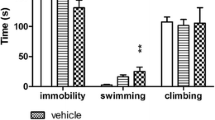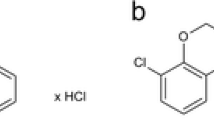Abstract
Rationale
Tramadol, (1RS,2RS)-2-[(dimethylamine)-methyl]-1-(3-methoxyphenyl)-cyclohexanol hydrochloride, is an atypical analgesic which binds weakly to ì-opioid receptors and enhances the extra-neuronal concentration of noradrenaline and serotonin by interference with both the uptake and release mechanisms.
Objectives
The present study was undertaken to evaluate the potential role of 5-HT1A and 5-HT1B receptors on the analgesic and antidepressant-like effect of tramadol.
Methods
The effect of either a selective 5-HT1A receptor antagonist (WAY 100635; N-2-[4-(2-methoxyphenyl-1-piperazinyl]ethyl]-N-2-pyridinylcyclohexane carboxamide; 0.2–0.8, 8 mg/kg) or a selective 5-HT1B receptor antagonist (SB 216641; N-[3-(3-dimethylamino) ethoxy-4-methoxyphenyl]-2′-methyl-4′-(5-methyl-1,2,4-oxadiazol-3-yl)-(1,1′-biphenyl)-4-carboxamide; 0.2–0.8, 8 mg/kg) was investigated in mice in combination with tramadol by means of the hot-plate test, a phasic nociceptive model, and the forced swimming test, a paradigm aimed at screening potential antidepressants.
Results
The results showed that WAY 100635 enhanced the antinociceptive effect and produced a large decrease in the antidepressant-like effect of tramadol. In contrast, SB 216641 did not significantly modify either the analgesic or the antidepressant-like effects of tramadol.
Conclusions
These findings suggest that 5-HT1A receptors modulate the analgesic and the antidepressant-like effects of tramadol in differing ways. The results suggest the involvement of the 5-HT1A autoreceptors from the raphe nuclei and spinal 5-HT1A receptors in the antinociceptive effect. In contrast, the 5-HT1A receptors located in the forebrain may be responsible for the blockade of the antidepressant-like effect of tramadol. 5-HT1B receptors seem not to modify these effects in the models investigated.




Similar content being viewed by others
References
Adell A, Castro E, Celada P, Bortolozzi A, Pazos A, Artigas F (2005) Strategies for producing faster acting antidepressants. Drug Discov Today 10:578–585
Alhaider AA, Wilcox GL (1993) Differential roles of 5-hydroxytryptamine1A and 5-hydroxytryptamine1B receptor subtypes in modulating spinal nociceptive transmission in mice. J Pharmacol Exp Ther 265:378–385
Ali Z, Wu G, Kozlov A, Barasi S (1994) The actions of 5-HT1 agonists and antagonists on nociceptive processing in the rat spinal cord: results from behavioural and electrophysiological studies. Brain Res 661:83–90
Ardid D, Alloui A, Brousse G, Jourdan D, Picard P, Dubray C, Eschalier A (2001) Potentiation of the antinociceptive effect of clomipramine by a 5-ht(1A) antagonist in neuropathic pain in rats. Br J Pharmacol 132:1118–1126
Bamigbade TA, Davidson C, Langford RM, Stamford JA (1997) Actions of tramadol, its enantiomers and principal metabolite, O-desmethyltramadol, on serotonin (5-HT) efflux and uptake in the rat dorsal raphe nucleus. Br J Anaesth 79:352–356
Bardin L, Colpaert FC (2004) Role of spinal 5-HT(1A) receptors in morphine analgesia and tolerance in rats. Eur J Pain 8:253–261
Beique JC, Blier P, de Montigny C, Debonnel G (2000) Potentiation by (−)Pindolol of the activation of postsynaptic 5-HT(1A) receptors induced by venlafaxine. Neuropsychopharmacology 23:294–306
Berrocoso E, Mico JA, Ugedo L (2006) In vivo effect of tramadol on locus coeruleus neurons is mediated by alpha2-arenoceptors and modulated by serotonin. Neuropharmacology (in press)
Bonnefont J, Chapuy E, Clottes E, Alloui A, Eschalier A (2005) Spinal 5-HT1A receptors differentially influence nociceptive processing according to the nature of the noxious stimulus in rats: effect of WAY-100635 on the antinociceptive activities of paracetamol, venlafaxine and 5-HT. Pain 114:482–490
Bosker FJ, Klompmakers A, Westenberg HG (1997) Postsynaptic 5-HT1A receptors mediate 5-hydroxytryptamine release in the amygdala through a feedback to the caudal linear raphe. Eur J Pharmacol 333:147–157
Casanovas JM, Hervas I, Artigas F (1999) Postsynaptic 5-HT1A receptors control 5-HT release in the rat medial prefrontal cortex. Neuroreport 10:1441–1445
Driessen B, Reimann W, Giertz H (1993) Effects of the central analgesic tramadol on the uptake and release of noradrenaline and dopamine in vitro. Br J Pharmacol 108:806–811
Eide PK, Joly NM, Hole K (1990) The role of spinal cord 5-HT1A and 5-HT1B receptors in the modulation of a spinal nociceptive reflex. Brain Res 536:195–200
Fanelli J, Montgomery C (1998) Use of the analgesic tramadol in antidepressant potentiation. Psychopharmacol Bull 32:442
Faron-Gorecka A, Kusmider M, Inan SY, Siwanowicz J, Dziedzicka-Wasylewska M (2004a) Effects of tramadol on alpha2-adrenergic receptors in the rat brain. Brain Res 1016:263–267
Faron-Gorecka A, Kusmider M, Inan SY, Siwanowicz J, Piwowarczyk T, Dziedzicka-Wasylewska M (2004b) Long-term exposure of rats to tramadol alters brain dopamine and alpha 1-adrenoceptor function that may be related to antidepressant potency. Eur J Pharmacol 501:103–110
Fletcher A, Forster EA, Bill DJ, Brown G, Cliffe IA, Hartley JE, Jones DE, McLenachan A, Stanhope KJ, Critchley DJ, Childs KJ, Middlefell VC, Lanfumey L, Corradetti R, Laporte AM, Gozlan H, Hamon M, Dourish CT (1996) Electrophysiological, biochemical, neurohormonal and behavioural studies with WAY-100635, a potent, selective and silent 5-HT1A receptor antagonist. Behav Brain Res 73:337–353
Goldsmith TB, Shapira NA, Keck PE Jr (1999) Rapid remission of OCD with tramadol hydrochloride. Am J Psychiatry 156:660–661
Haddjeri N, Blier P, de Montigny C (1998) Long-term antidepressant treatments result in a tonic activation of forebrain 5-HT1A receptors. J Neurosci 18:10150–10156
Hains BC, Willis WD, Hulsebosch CE (2003) Serotonin receptors 5-HT1A and 5-HT3 reduce hyperexcitability of dorsal horn neurons after chronic spinal cord hemisection injury in rat. Exp Brain Res 149:174–186
Hennies HH, Friderichs E, Schneider J (1988) Receptor binding, analgesic and antitussive potency of tramadol and other selected opioids. Arzneimittelforschung 38:877–880
Hopwood SE, Owesson CA, Callado LF, McLaughlin DP, Stamford JA (2001) Effects of chronic tramadol on pre- and post-synaptic measures of monoamine function. J Psychopharmacol 15:147–153
Le Bars D, Gozariu M, Cadden SW (2001) Animal models of nociception. Pharmacol Rev 53:597–652
Markowitz JS, Patrick KS (1998) Venlafaxine-tramadol similarities. Med Hypotheses 51:167–168
Mico JA, Berrocoso E, Ortega-Alvaro A, Gibert-Rahola J, Rojas-Corrales MO (2006) The role of 5-HT1A receptors in research strategy for extensive pain treatment. Curr Top Med Chem (in press)
Millan MJ (2002) Descending control of pain. Prog Neurobiol 66:355–474
Porsolt RD, Le Pichon M, Jalfre M (1977) Depression: a new animal model sensitive to antidepressant treatments. Nature 266:730–732
Roca-Vinardell A, Ortega-Alvaro A, Gibert-Rahola J, Mico JA (2003) The role of 5-HT1A/B autoreceptors in the antinociceptive effect of systemic administration of acetaminophen. Anesthesiology 98:741–747
Rojas-Corrales MO, Gibert-Rahola J, Mico JA (1998) Tramadol induces antidepressant-type effects in mice. Life Sci 63:L175–L180
Rojas-Corrales MO, Ortega-Alvaro A, Gibert-Rahola J, Roca-Vinardell A, Mico JA (2000) Pindolol, a beta-adrenoceptor blocker/5-hydroxytryptamine(1A/1B) antagonist, enhances the analgesic effect of tramadol. Pain 88:119–124
Rojas-Corrales MO, Berrocoso E, Gibert-Rahola J, Mico JA (2002) Antidepressant-like effects of tramadol and other central analgesics with activity on monoamines reuptake, in helpless rats. Life Sci 72:143–152
Rojas-Corrales MO, Berrocoso E, Gibert-Rahola J, Mico JA (2004) Antidepressant-like effect of tramadol and its enantiomers in reserpinized mice: comparative study with desipramine, fluvoxamine, venlafaxine and opiates. J Psychopharmacol 18:404–411
Rojas-Corrales MO, Berrocoso E, Mico JA (2005) Role of 5-HT1A and 5-HT1B receptors in the antinociceptive effect of tramadol. Eur J Pharmacol 511:21–26
Sari Y (2004) Serotonin1B receptors: from protein to physiological function and behavior. Neurosci Biobehav Rev 28:565–582
Sasaki M, Ishizaki K, Obata H, Goto F (2001) Effects of 5-HT2 and 5-HT3 receptors on the modulation of nociceptive transmission in rat spinal cord according to the formalin test. Eur J Pharmacol 424:45–52
Sawynok J, Reid A (1994) Spinal supersensitivity to 5-HT1, 5-HT2 and 5-HT3 receptor agonists following 5,7-dihydroxytryptamine. Eur J Pharmacol 264:249–257
Shapira NA, Keck PE, Jr., Goldsmith TD, McConville BJ, Eis M, McElroy SL (1997) Open-label pilot study of tramadol hydrochloride in treatment–refractory obsessive–compulsive disorder. Depress Anxiety 6:170–173
Shapira NA, Verduin ML, DeGraw JD (2001) Treatment of refractory major depression with tramadol monotherapy. J Clin Psychiatry 62:205–206
Spencer C (2000) The efficacy of intramuscular tramadol as a rapid-onset antidepressant. Aust N Z J Psychiatry 34:1032–1033
Sprouse JS, Aghajanian GK (1987) Electrophysiological responses of serotoninergic dorsal raphe neurons to 5-HT1A and 5-HT1B agonists. Synapse 1:3–9
Stamford JA, Davidson C, McLaughlin DP, Hopwood SE (2000) Control of dorsal raphe 5-HT function by multiple 5-HT(1) autoreceptors: parallel purposes or pointless plurality? Trends Neurosci 23:459–465
Tatarczynska E, Klodzinska A, Stachowicz K, Chojnacka-Wojcik E (2004) Effect of combined administration of 5-HT1A or 5-HT1B/1D receptor antagonists and antidepressants in the forced swimming test. Eur J Pharmacol 487:133–142
Verge D, Calas A (2000) Serotoninergic neurons and serotonin receptors: gains from cytochemical approaches. J Chem Neuroanat 18:41–56
Wang QP, Nakai Y (1994) The dorsal raphe: an important nucleus in pain modulation. Brain Res Bull 34:575–585
Woolfe G, McDonald AD (1944) The evaluation of the analgesic action of pethidine hydrochloride (Demerol). J Pharmacol Exp Ther 80:300
Xu W, Qiu XC, Han JS (1994) Serotonin receptor subtypes in spinal antinociception in the rat. J Pharmacol Exp Ther 269:1182–1189
Zimmermann M (1983) Ethical guidelines for investigations of experimental pain in conscious animals. Pain 16:109–110
Acknowledgements
This study has been supported by “Fondo de Investigación Sanitaria” (PI031430) and “Plan Andaluz de Investigación” (CTS-510).
Author information
Authors and Affiliations
Corresponding author
Rights and permissions
About this article
Cite this article
Berrocoso, E., Rojas-Corrales, M.O. & Mico, J.A. Differential role of 5-HT1A and 5-HT1B receptors on the antinociceptive and antidepressant effect of tramadol in mice. Psychopharmacology 188, 111–118 (2006). https://doi.org/10.1007/s00213-006-0464-6
Received:
Accepted:
Published:
Issue Date:
DOI: https://doi.org/10.1007/s00213-006-0464-6




